Antioxidant Enzyme Activities and Lipid Oxidation in Rape (Brassica campestris L.) Bee Pollen Added to Salami during Processing
Abstract
:1. Introduction
2. Results and Discussion
2.1. Identification and Quantification of Flavonoid Compounds
2.2. Total Antioxidant Capacity of RBP Extract
2.3. Effect of RBP Extract on the Endogenous Antioxidant Enzymatic Activities in Salami during Processing
2.3.1. GSH-Px Activity
2.3.2. CAT Activity
2.3.3. SOD Activity
2.4. Effect of RBP or RBP Extract on Lipid Oxidation in Salami
3. Materials and Methods
3.1. Preparation of RBP Extract
3.2. Total Flavonoid Content
3.3. Identification and Quantification of Flavonoid Compounds
3.4. Total Antioxidant Capacity of RBP Extract
3.5. Preparation of Salami Samples
3.6. Measurement of Endogenous Antioxidant Enzyme Activities of Salami
3.6.1. GSH-Px Activity
3.6.2. CAT Activity
3.6.3. SOD Activity
3.7. Salami Lipid Oxidation
3.8. Statistical Analysis
4. Conclusions
Acknowledgments
Author Contributions
Conflicts of Interest
References
- Hur, S.J.; Park, G.B.; Joo, S.T. Formation of cholesterol oxidation products (COPs) in animal products. Food Control 2007, 18, 939–947. [Google Scholar] [CrossRef]
- Wójciak, K.M.; Dolatowski, Z.J. Oxidative stability of fermented meat products. Acta Sci. Pol. Technol. Aliment. 2012, 11, 99–109. [Google Scholar] [PubMed]
- Sammet, K.; Duehlmeier, R.; Sallmann, H.P.; von Canstein, C.; von Mueffling, T.; Nowak, B. Assessment of the antioxidative potential of dietary supplementation with α-tocopherol in low-nitrite salami-type sausages. Meat Sci. 2006, 72, 270–279. [Google Scholar] [CrossRef] [PubMed]
- Wirth, F. Reducing the fat and sodium content of meat products. What possibilities are there? FleischWirtschaft 1991, 71, 294–297. [Google Scholar]
- Kim, S.J.; Cho, A.R.; Han, J. Antioxidant and antimicrobial activities of leafy green vegetable extracts and their applications to meat product preservation. Food Control 2013, 29, 112–120. [Google Scholar] [CrossRef]
- Soong, Y.Y.; Barlow, P.J. Antioxidant activity and phenolic content of selected fruit seeds. Food Chem. 2004, 88, 411–417. [Google Scholar] [CrossRef]
- Madhavi, D.L.; Salunkhe, D.K. Toxicological aspects of food antioxidants. Food Sci. Technol. 1995, 267, 267–360. [Google Scholar]
- Qi, S.; Huang, H.; Huang, J.; Wang, Q.; Wei, Q. Lychee (Litchi chinensis Sonn.) seed water extract as potential antioxidant and anti-obese natural additive in meat products. Food Control 2015, 50, 195–201. [Google Scholar] [CrossRef]
- Sebranek, J.G.; Sewalt, V.J.H.; Robbins, K.; Houser, T.A. Comparison of a natural rosemary extract and BHA/BHT for relative antioxidant effectiveness in pork sausage. Meat Sci. 2005, 69, 289–296. [Google Scholar] [CrossRef] [PubMed]
- Nassu, R.T.; Gonçalves, L.A.G.; da Silva, M.A.A.P.; Beserra, F.J. Oxidative stability of fermented goat meat sausage with different levels of natural antioxidant. Meat Sci. 2003, 63, 43–49. [Google Scholar] [CrossRef]
- Campagnol, P.C.B.; Fries, L.L.M.; Terra, N.N.; Santos, B.A.D.; Furtado, A.S.; Toneto, E.R.L.; Campos, R.M.L.D. The influence of Achyrocline satureioides (“Marcela”) extract on the lipid oxidation of salami. Food Sci. Technol. 2011, 31, 101–105. [Google Scholar] [CrossRef]
- Karre, L.; Lopez, K.; Getty, K.J.K. Natural antioxidants in meat and poultry products. Meat Sci. 2013, 94, 220–227. [Google Scholar] [CrossRef] [PubMed]
- Žilić, S.; Vančetović, J.; Janković, M.; Maksimović, V. Chemical composition, bioactive compounds, antioxidant capacity and stability of floral maize (Zea mays L.) pollen. J. Funct. Foods 2014, 10, 65–74. [Google Scholar] [CrossRef]
- LeBlanc, B.W.; Davis, O.K.; Boue, S.; DeLucca, A.; Deeby, T. Antioxidant activity of Sonoran Desert bee pollen. Food Chem. 2009, 115, 1299–1305. [Google Scholar] [CrossRef]
- Abouda, Z.; Zerdani, I.; Kalalou, I.; Faid, M.; Ahami, M.T. The antibacterial activity of Moroccan bee bread and bee-pollen (fresh and dried) against pathogenic bacteria. Res. J. Microbiol. 2011, 6, 376–384. [Google Scholar]
- Wagenlehner, F.M.; Schneider, H.; Ludwig, M.; Schnitker, J.; Brähler, E.; Weidner, W. A pollen extract (Cernilton) in patients with inflammatory chronic prostatitis-chronic pelvic pain syndrome: A multicentre, randomised, prospective, double-blind, placebo-controlled phase 3 study. Eur. Urol. 2009, 56, 544–551. [Google Scholar] [CrossRef] [PubMed]
- Lv, H.; Wang, X.; He, Y.; Wang, H.; Suo, Y. Identification and quantification of flavonoid aglycones in rape bee pollen from Qinghai-Tibetan Plateau by HPLC-DAD-APCI/MS. J. Food Compos. Anal. 2015, 38, 49–54. [Google Scholar] [CrossRef]
- Eraslan, G.; Kanbur, M.; Silici, S.; Liman, B.C.; Altınordulu, Ş.; Sarıca, Z.S. Evaluation of protective effect of bee pollen against propoxur toxicity in rat. Ecotoxicol. Environ. Saf. 2009, 72, 931–937. [Google Scholar] [CrossRef] [PubMed]
- Eraslan, G.; Kanbur, M.; Silici, S. Effect of carbaryl on some biochemical changes in rats: The ameliorative effect of bee pollen. Food Chem. Toxicol. 2009, 47, 86–91. [Google Scholar] [CrossRef] [PubMed]
- Hernández, P.; Zomeño, L.; Ariño, B.; Blasco, A. Antioxidant, lipolytic and proteolytic enzyme activities in pork meat from different genotypes. Meat Sci. 2004, 66, 525–529. [Google Scholar] [CrossRef]
- Sánchez-Rabaneda, F.; Jáuregui, O.; Casals, I.; Andrés-Lacueva, C.; Izquierdo-Pulido, M.; Lamuela-Raventós, R.M. Liquid chromatographic/electrospray ionization tandem mass spectrometric study of the phenolic composition of cocoa (Theobroma cacao). J. Mass Spectrom. 2003, 38, 35–42. [Google Scholar] [CrossRef] [PubMed]
- N’Dri, D.; Calani, L.; Mazzeo, T.; Scazzina, F.; Rinaldi, M.; Del Rio, D.; Brighenti, F. Effects of different maturity stages on antioxidant content of Ivorian Gnagnan (Solanum indicum L.) berries. Molecules 2010, 15, 7125–7138. [Google Scholar] [CrossRef] [PubMed]
- Ribas-Agustí, A. A validated HPLC-DAD method for routine determination of ten phenolic compounds in tomato fruits. Food Anal. Methods 2012, 5, 1137–1144. [Google Scholar] [CrossRef]
- Kaškonienė, V.; Ruočkuvienė, G.; Kaškonas, P.; Akuneca, I.; Maruška, A. Chemometric Analysis of Bee Pollen Based on Volatile and Phenolic Compound Compositions and Antioxidant Properties. Food Anal. Methods 2015, 8, 1150–1163. [Google Scholar] [CrossRef]
- Arruda, L.; Beneduzi, A.; Martins, A.; Lisboa, B.; Lopes, C.; Bertolo, F.; Passaglia, L.M.P.; Vargas, L.K. Screening of rhizobacteria isolated from maize (Zea mays L.) in Rio Grande do Sul State (South Brazil) and analysis of their potential to improve plant growth. Appl. Soil Ecol. 2013, 63, 15–22. [Google Scholar] [CrossRef]
- Melo, I.L.P.D.; Freitas, A.S.D.; Barth, O.M.; Almeida-Muradian, L.B.D. Correlation between nutritional composition and floral origin of dried bee pollen. Revista do Instituto Adolfo Lutz 2009, 68, 346–353. [Google Scholar]
- Kullisaar, T.; Zilmer, M.; Mikelsaar, M.; Vihalemm, T.; Annuk, H.; Kairane, C.; Kilk, A. Two antioxidative lactobacilli strains as promising probiotics. Int. J. Food Microbiol. 2002, 72, 215–224. [Google Scholar] [CrossRef]
- Sárraga, C.; Carreras, I.; Regueiro, J.A.G. Influence of meat quality and NaCl percentage on glutathione peroxidase activity and values for acid-reactive substances of raw and dry-cured Longissimus dorsi. Meat Sci. 2002, 62, 503–507. [Google Scholar] [CrossRef]
- Jin, G.; He, L.; Yu, X.; Zhang, J.; Ma, M. Antioxidant enzyme activities are affected by salt content and temperature and influence muscle lipid oxidation during dry-salted bacon processing. Food Chem. 2013, 141, 2751–2756. [Google Scholar] [CrossRef] [PubMed]
- Naik, S.R.; Panda, V.S. Antioxidant and hepatoprotective effects of Ginkgo biloba phytosomes in carbon tetrachloride-induced liver injury in rodents. Liver Int. 2007, 27, 393–399. [Google Scholar] [CrossRef] [PubMed]
- Cheng, N.; Ren, N.; Gao, H.; Lei, X.; Zheng, J.; Cao, W. Antioxidant and hepatoprotective effects of Schisandra chinensis pollen extract on CCl4-induced acute liver damage in mice. Food Chem. Toxicol. 2013, 55, 234–240. [Google Scholar] [CrossRef] [PubMed]
- Li, S.; Pu, X.P. Neuroprotective effect of kaempferol against a 1-methyl-4-phenyl-1,2,3,6-tetrahydropyridine-induced mouse model of Parkinson’s disease. Biol. Pharm. Bull. 2011, 34, 1291–1296. [Google Scholar] [CrossRef] [PubMed]
- Šarić, A.; Balog, T.; Sobočanec, S.; Kušić, B.; Šverko, V.; Rusak, G.; Likić, S.; Bubalo, D.; Pinto, B.; Reali, D.; Marotti, T. Antioxidant effects of flavonoid from Croatian Cystus incanus L. rich bee pollen. Food Chem. Toxicol. 2009, 47, 547–554. [Google Scholar] [CrossRef] [PubMed]
- Coskun, O.; Kanter, M.; Korkmaz, A.; Oter, S. Quercetin, a flavonoid antioxidant, prevents and protects streptozotocin-induced oxidative stress and β-cell damage in rat pancreas. Pharmacol. Res. 2005, 51, 117–123. [Google Scholar] [CrossRef] [PubMed]
- Molina, M.F.; Sanchez-Reus, I.; Iglesias, I.; Benedi, J. Quercetin, a flavonoid antioxidant, prevents and protects against ethanol-induced oxidative stress in mouse liver. Biol. Pharm. Bull. 2003, 26, 1398–1402. [Google Scholar] [CrossRef] [PubMed]
- Hu, C.H.; Wang, D.G.; Pan, H.Y.; Zheng, W.B.; Zuo, A.Y.; Liu, J.X. Effects of broccoli stem and leaf meal on broiler performance, skin pigmentation, antioxidant function, and meat quality. Poult. Sci. 2012, 91, 2229–2234. [Google Scholar] [CrossRef] [PubMed]
- Reiter, R.J.; Tan, D.X.; Osuna, C.; Gitto, E. Actions of melatonin in the reduction of oxidative stress. J. Biomed. Sci. 2000, 7, 444–458. [Google Scholar] [CrossRef] [PubMed]
- Bartosz, G. Superoxide dismutases and catalase. In Reactions, Processes; Springer: Berlin/Heidelberg, Germany, 2005; pp. 109–149. [Google Scholar]
- Lee, M.A.; Choi, J.H.; Choi, Y.S.; Han, D.J.; Kim, H.Y.; Shim, S.Y.; Chung, H.K.; Kim, C.J. The antioxidative properties of mustard leaf (Brassica juncea) kimchi extracts on refrigerated raw ground pork meat against lipid oxidation. Meat Sci. 2010, 84, 498–504. [Google Scholar] [CrossRef] [PubMed]
- Hassan, O.; Fan, L.S. The anti-oxidation potential of polyphenol extract from cocoa leaves on mechanically deboned chicken meat (MDCM). LWT-Food Sci. Technol. 2005, 38, 315–321. [Google Scholar] [CrossRef]
- Lupea, A.X.; Pop, M.; Cacig, S. Structure-radical scavenging activity relationships of flavonoids from Ziziphus and Hydrangea extracts. Rev. Chim. 2008, 59, 309–313. [Google Scholar]
- Silva, M.M.; Santos, M.R.; Caroço, G.; Rocha, R.; Justino, G.; Mira, L. Structure-antioxidant activity relationships of flavonoids: A re-examination. Free Radic. Res. 2002, 36, 1219–1227. [Google Scholar] [CrossRef] [PubMed]
- Hidalgo, M.; Sánchez-Moreno, C.; de Pascual-Teresa, S. Flavonoid-flavonoid interaction and its effect on their antioxidant activity. Food Chem. 2010, 121, 691–696. [Google Scholar] [CrossRef]
- Yang, L.C.; Li, R.; Tan, J.; Jiang, Z.T. Polyphenolics composition of the leaves of Zanthoxylum bungeanum Maxim. grown in Hebei, China, and their radical scavenging activities. J. Agric. Food Chem. 2013, 61, 1772–1778. [Google Scholar] [CrossRef] [PubMed]
- Zhishen, J.; Mengcheng, T.; Jianming, W. The determination of flavonoid contents in mulberry and their scavenging effects on superoxide radicals. Food Chem. 1999, 64, 555–559. [Google Scholar] [CrossRef]
- Li, J.; Wang, F.; Li, S.; Peng, Z. Effects of pepper (Zanthoxylum bungeanum Maxim.) leaf extract on the antioxidant enzyme activities of salted silver carp (Hypophthalmichthys molitrix) during processing. J. Funct. Foods 2015, 18, 1179–1190. [Google Scholar] [CrossRef]
- Lawrence, R.A.; Burk, R.F. Glutathione peroxidase activity in selenium-deficient rat liver. Biochem. Biophys. Res. Commun. 1976, 71, 952–958. [Google Scholar] [CrossRef]
- Cakmak, I.; Marschner, H. Magnesium deficiency and high light intensity enhance activities of superoxide dismutase, ascorbate peroxidase, and glutathione reductase in bean leaves. Plant Physiol. 1992, 98, 1222–1227. [Google Scholar] [CrossRef] [PubMed]
- Marklund, S.; Marklund, G. Involvement of the superoxide anion radical in the autoxidation of pyrogallol and a convenient assay for superoxide dismutase. Eur. J. Biochem. 1974, 47, 469–474. [Google Scholar] [CrossRef] [PubMed]
- Shantha, N.C.; Decker, E.A. Rapid, sensitive, iron-based spectrophotometric methods for determination of peroxide values of food lipids. J. AOAC Int. 1994, 77, 421–424. [Google Scholar] [PubMed]
- Salih, A.M.; Smith, D.M.; Price, J.F.; Dawson, L.E. Modified extraction 2-thiobarbituric acid method for measuring lipid oxidation in poultry. Poult. Sci. 1987, 66, 1483–1488. [Google Scholar] [CrossRef] [PubMed]
- Sample Availability: Samples of the compounds are available from the authors.
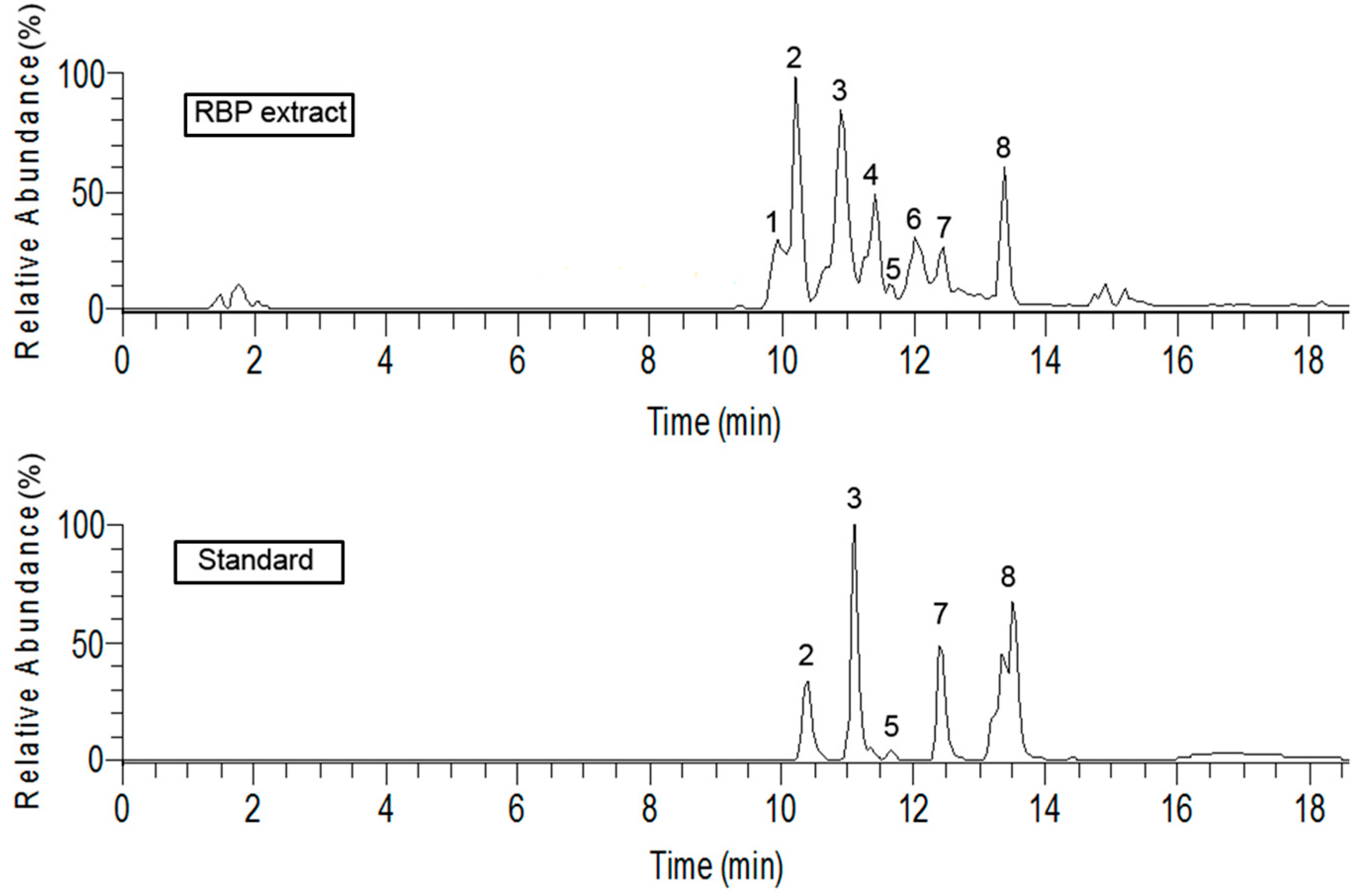
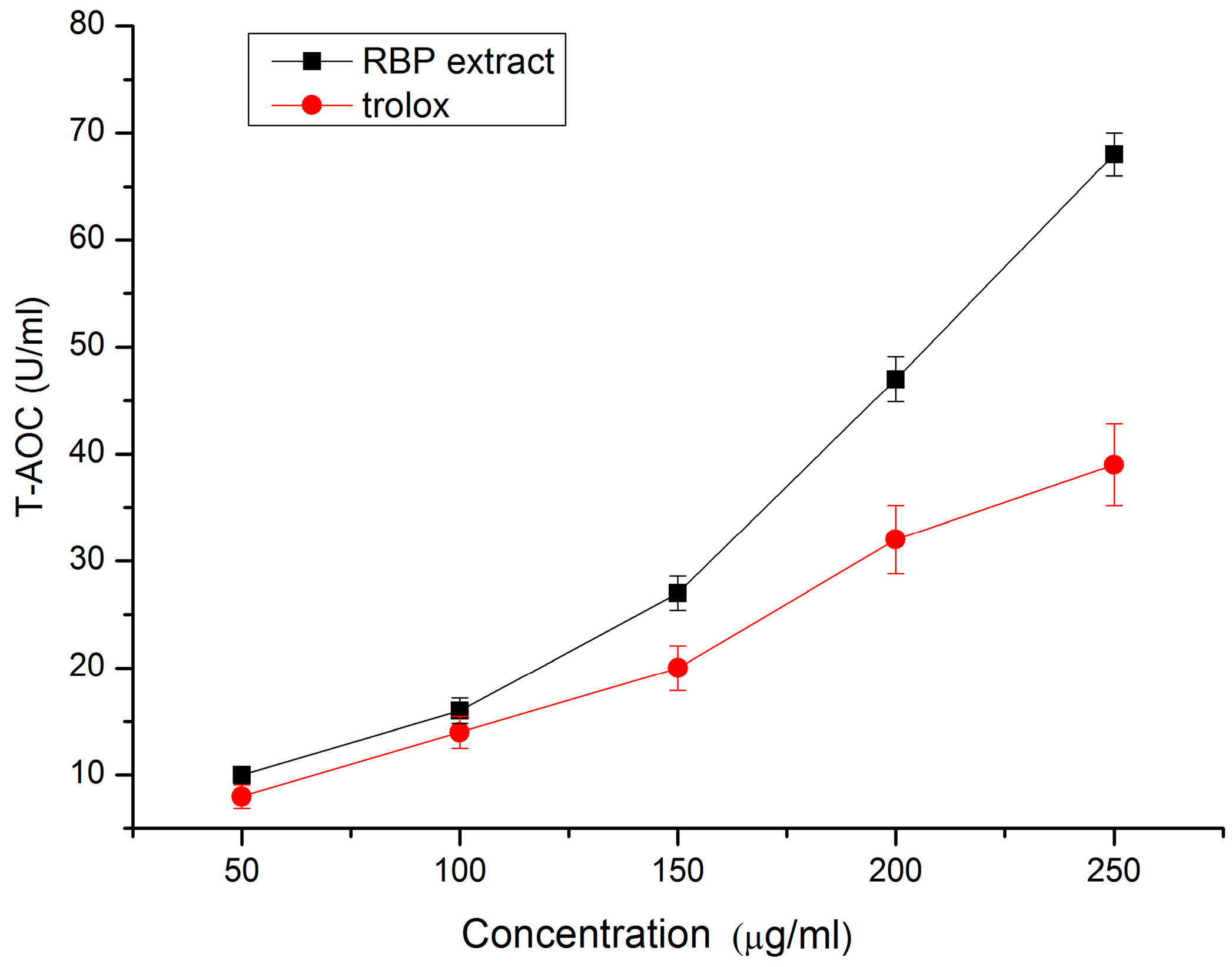
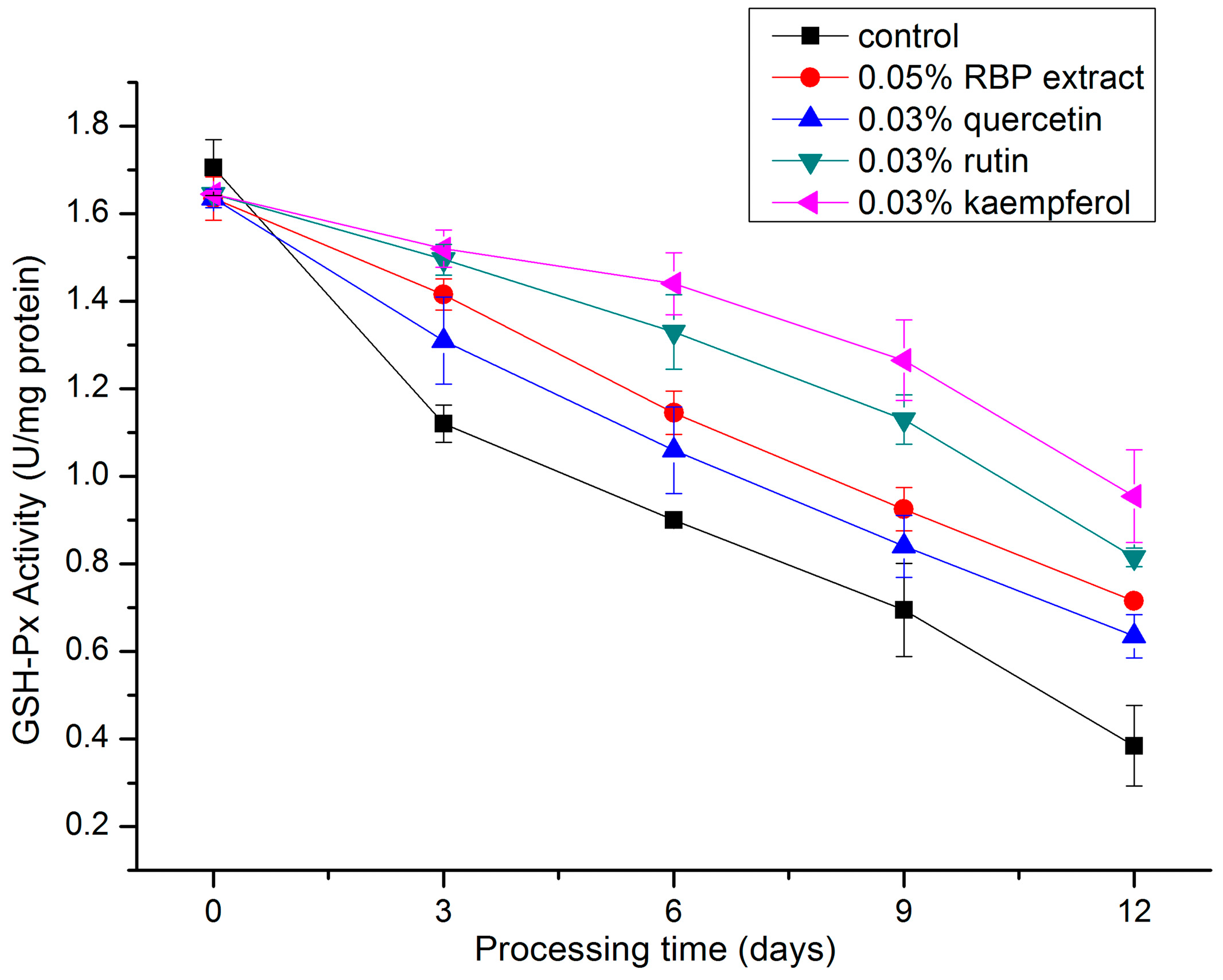
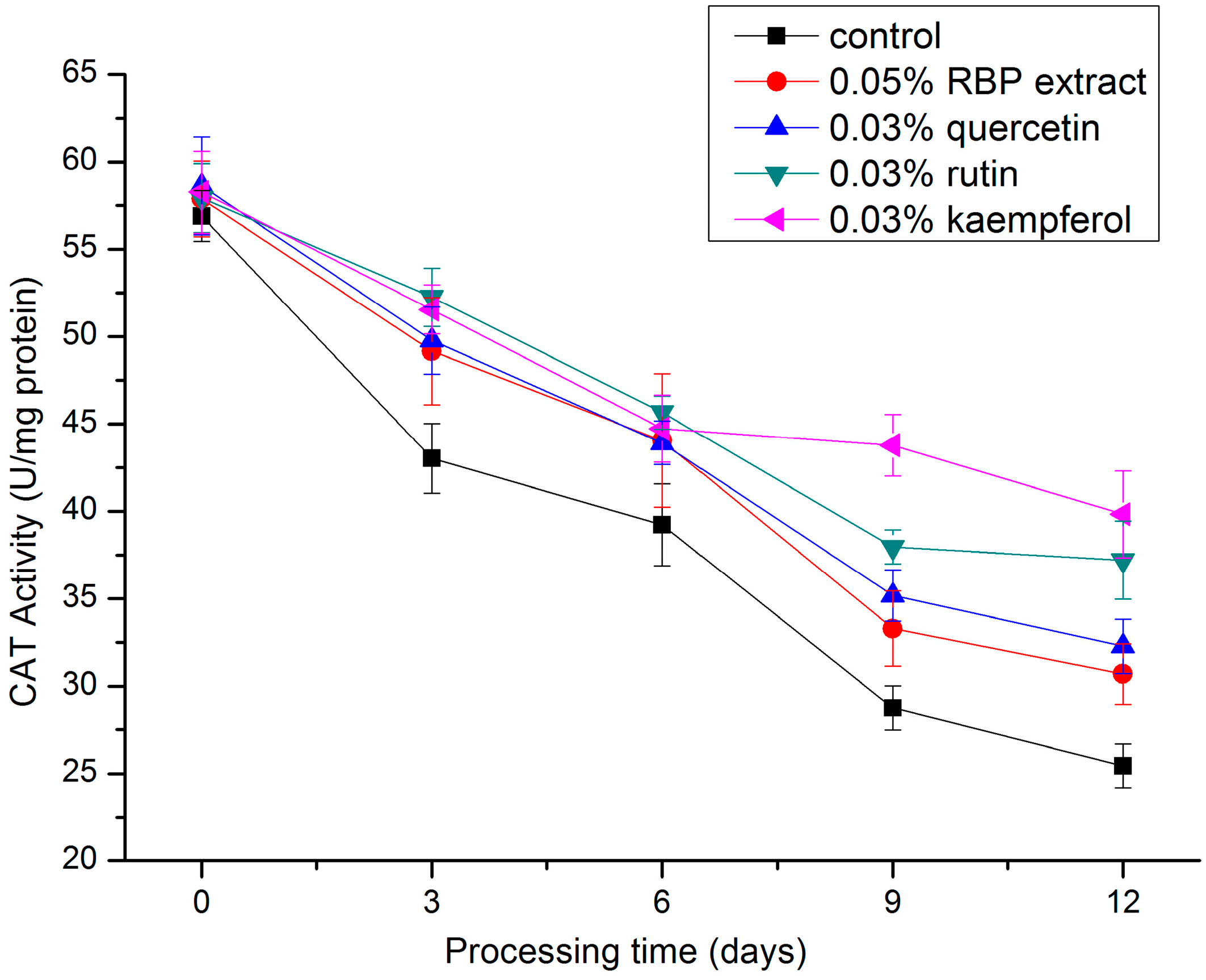
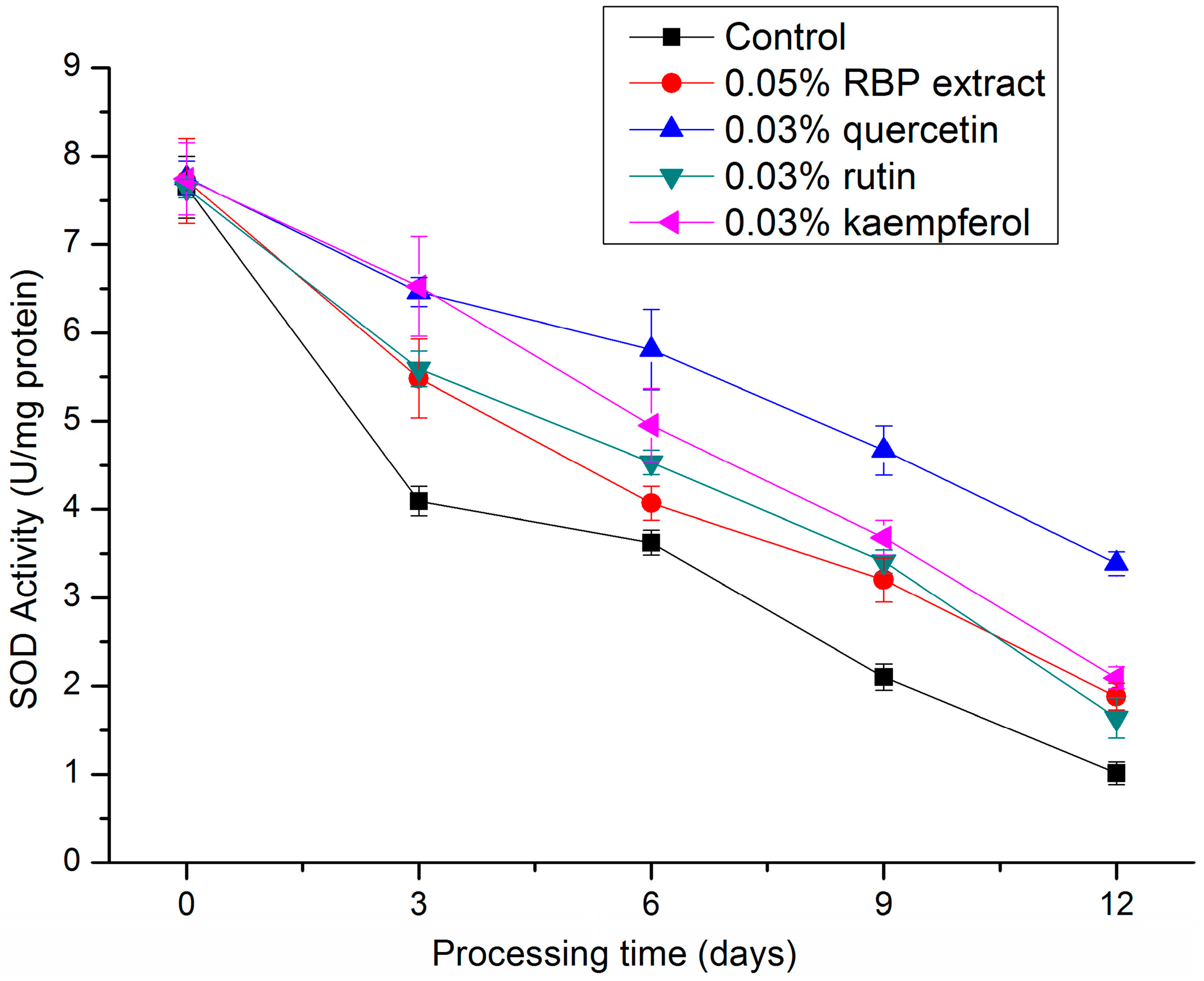
| Peak | Compounds | [M − H]− (m/z) | RT (min) Sample | RT (min) Standard | Predicted Formula | Calibration Curve | ppm | Linear Range (μg/mg) | R2 | Content (mg/g) | LOQ (ng/mL) |
|---|---|---|---|---|---|---|---|---|---|---|---|
| 1 | Quercetin 3-O-glucoside | 463.0853 | 9.94 | - | C21H19O12 | - | −2.889 | - | - | 20.21 ± 0.02 a | - |
| 2 | Rutin | 609.1429 | 10.39 | 10.44 | C27H29O16 | y = 2.6985 × 106x − 412038 | −5.299 | 0.1–100 | 0.99 | 35.52 ± 0.01 | 100 |
| 3 | Quercitrin | 447.0906 | 10.99 | 11.10 | C21H20O11 | y = 3.9898 × 106x − 3144208 | −5.982 | 0.1–100 | 0.99 | 21.25 ± 0.01 | 100 |
| 4 | Kaempferol 3-O-glucoside | 447.0909 | 11.40 | - | C21H19O11 | - | −2.435 | - | - | 19.13 ± 0.02 a | - |
| 5 | Quercetin | 301.0339 | 11.71 | 11.73 | C15H9O7 | y = 7.263 × 106x − 3671831 | −5.002 | 0.1–100 | 0.99 | 38.68 ± 0.01 | 100 |
| 6 | Naringenin | 271.0603 | 12.09 | - | C15H11O5 | - | −3.618 | - | - | 26.57 ± 0.02 a | - |
| 7 | Kaempferol | 285.0394 | 12.46 | 12.49 | C15H9O6 | y = 7.640 × 106x − 67030 | −3.308 | 0.1–100 | 0.99 | 145.15 ± 0.04 | 100 |
| 8 | Isorhamnetin | 315.0495 | 13.38 | 13.50 | C16H11O7 | y = 6.1311 × 106x− 2323606 | −4.748 | 0.01–100 | 0.99 | 3.25 ± 0.01 | 10 |
| Effect Tested | SOD Activity | CAT Activity | GSH-Px Activity |
|---|---|---|---|
| Treatments (T) | |||
| Control | 3.70 ± 2.34d | 38.67 ± 11.66d | 0.96 ± 0.46e |
| 0.05% RBP extract | 4.47 ± 2.08c | 43.02 ± 10.66c | 1.18 ± 0.33c |
| 0.03% Quercetin | 5.62 ± 1.55a | 43.96 ± 10.08b,c | 1.10 ± 0.36d |
| 0.03% Rutin | 4.56 ± 2.09c | 46.21 ± 8.44a,b | 1.27 ± 0.31b |
| 0.03% Kaempferol | 5.00 ± 2.08b | 47.63 ± 6.96a | 1.37 ± 0.25a |
| Significance | *** | *** | *** |
| Processing days (D) | |||
| 0 | 7.70 ± 0.10A | 57.92 ± 1.95A | 1.65 ± 0.04A |
| 3 | 5.63 ± 0.92B | 49.15 ± 3.81B | 1.37 ± 0.15B |
| 6 | 4.60 ± 0.78C | 43.52 ± 3.01C | 1.18 ± 0.20C |
| 9 | 3.41 ± 0.86D | 35.80 ± 5.34D | 0.97 ± 0.22D |
| 12 | 2.00 ± 0.81E | 33.09 ± 5.47E | 0.70 ± 0.20E |
| Significance | *** | *** | *** |
| Interaction T × D | *** | *** | *** |
| Lipid Oxidation Indices | Treatments | Processing Time (Days) | ||||
|---|---|---|---|---|---|---|
| 0 | 3 | 6 | 9 | 12 | ||
| POV | control | 1.94 ± 0.18 j | 4.65 ± 0.28 h | 6.13 ± 0.08 d,e | 8.72 ± 0.41 a | 8.09 ± 0.13 b |
| 0.05% RBP extract | 1.99 ± 0.09 j | 4.23 ± 0.29 i | 5.76 ± 0.11 f | 7.21 ± 0.14 c | 6.21 ± 0.21 d | |
| 1% RBP | 2.09 ± 0.24 j | 3.96 ± 0.13 i | 5.58 ± 0.14 f,g | 7.22 ± 0.19 c | 6.33 ± 0.11 d | |
| TBARS | control | 0.23 ± 0.01 h | 0.32 ± 0.03 g | 0.57 ± 0.11 d,e | 0.87 ± 0.11 c | 1.32 ± 0.12 a |
| 0.05% RBP extract | 0.22 ± 0.01 h | 0.33 ± 0.02 g | 0.37 ± 0.04 g,f | 0.66 ± 0.14 d | 0.97 ± 0.09 b | |
| 1% RBP | 0.23 ± 0.01 h | 0.34 ± 0.02 g | 0.49 ± 0.03 e,f | 0.71 ± 0.14 d | 1.02 ± 0.09 b | |
| Effect Tested | POV | TBARS |
|---|---|---|
| Treatment (T) | ||
| Control | 5.91 ± 2.55a | 0.66 ± 0.42a |
| 0.05% RBP extract | 5.04 ± 1.89b | 0.56 ± 0.30b |
| 1% RBP | 5.08 ± 1.89b | 0.49 ± 0.25b |
| Significance | *** | *** |
| Processing days (D) | ||
| 0 | 2.01 ± 0.17E | 0.23 ± 0.01D |
| 3 | 4.28 ± 0.37D | 0.33 ± 0.02D |
| 6 | 5.83 ± 0.26C | 0.48 ± 0.10C |
| 9 | 7.72 ± 0.79A | 0.75 ± 0.15B |
| 12 | 6.88 ± 0.92B | 1.07 ± 0.22A |
| Significance | *** | *** |
| Interaction T × D | *** | ** |
© 2016 by the authors. Licensee MDPI, Basel, Switzerland. This article is an open access article distributed under the terms and conditions of the Creative Commons Attribution (CC-BY) license ( http://creativecommons.org/licenses/by/4.0/).
Share and Cite
Zhang, Y.; Yang, F.; Jamali, M.A.; Peng, Z. Antioxidant Enzyme Activities and Lipid Oxidation in Rape (Brassica campestris L.) Bee Pollen Added to Salami during Processing. Molecules 2016, 21, 1439. https://doi.org/10.3390/molecules21111439
Zhang Y, Yang F, Jamali MA, Peng Z. Antioxidant Enzyme Activities and Lipid Oxidation in Rape (Brassica campestris L.) Bee Pollen Added to Salami during Processing. Molecules. 2016; 21(11):1439. https://doi.org/10.3390/molecules21111439
Chicago/Turabian StyleZhang, Yawei, Fengtian Yang, Muneer Ahmed Jamali, and Zengqi Peng. 2016. "Antioxidant Enzyme Activities and Lipid Oxidation in Rape (Brassica campestris L.) Bee Pollen Added to Salami during Processing" Molecules 21, no. 11: 1439. https://doi.org/10.3390/molecules21111439
APA StyleZhang, Y., Yang, F., Jamali, M. A., & Peng, Z. (2016). Antioxidant Enzyme Activities and Lipid Oxidation in Rape (Brassica campestris L.) Bee Pollen Added to Salami during Processing. Molecules, 21(11), 1439. https://doi.org/10.3390/molecules21111439





